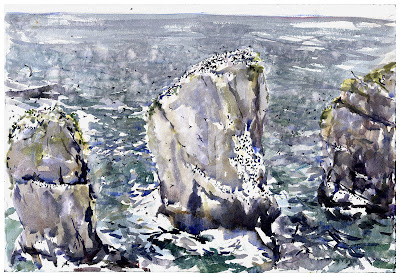Castlemartin's sea bird colonies are at most times a forbidden zone situated within an MOD on/offshore firing range. Visits have to be timed with pauses in firing; our first opportunity being between 16.30 - 21.30 last Tuesday. Travelling along the South coast we soon begin passing heavy military convoys before hitting the barracks where we turn onto a reinforced concrete lane, pausing to check - no red flags flying. The track
is direct to the sea, the land is sparse, save for the odd relic to its previous use; a chapel on the skyline and down a lane the shell of an old farm house. Giant scrapes laid by tanks and the sillouttes of Apache helicopters lined up on tarmac, faces like velociraptor, remind us of the short window of dormancy in this normally volatile patch, in which we safely pass to make our findings.
A dense sea fog had surged well inland that day bringing the kind of drizzle that hangs static in the space, charging the air with an atmosphere of suspense out of which are conjured gloomy shape shifting landscapes. This is how the colony revealed to us as we walked over the brow of the cliff seen in right of this picture, crammed at eye level on the central stack, a moated outpost fortified by shear numbers. Immediately jeapordy soars by in the wraith shape of a peregrine, greater black backed gulls patrol inches above the colony jabbing up and down at auks half their size like dancing puppets until large sections of the colony give way, in a cascade of black and white flight, leaving eggs and young vulnerable.
At eye level the birds whir by on a myriad of flight paths, drawing the various cliff tops, stacks and waves into a complex matrix of activity. On the main stack intimate behaviour can be watched closely at eye level, guillemots bow and nod to one another in constant communication that ripples through the colony in a constant swaying waving motion, accompanied with pulses of verbal gutteral gurgling rolling growls of consternation - oooOOOooAAAaooOOWWW!. From below Kitti-wake!! Kitti-Wake!! calls roll around the walls of sea caves before punching up over the clifftop din in an almighty eruption of volume. Razorbills sky point silently in pairs on the steepest ledges. Squinting through the turbulence of sea and mist, rafts of auks are pushed into view on the rising swell , more and more constellations of black bodies revealed in the time spent staring out over the ocean.
On the last day of our trip the access road reopens for a whole day. We return and paint through a day of sun, strong S Westerly and squally showers. A new aspect from the East is revealed and I enjoy taking in the whole scene from further back this time, taking in the merging movements of sea, birds, light and geology with this painting.
BS+UM. PB+UM - PB+ RU. QR+RU (UM), QR+UM, CY+UM(QR) see notes: Dec2011 - 2012





